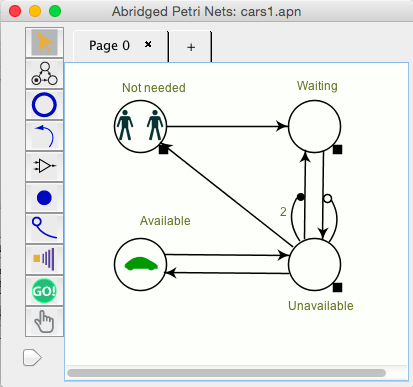Abridged Petri Nets (APN) is a visual tool for modeling of time-dependent non-deterministic behavior of complex systems using discrete event simulations. You can read a brief overview of the features provided here. It is convenient to identify three distinct functions of APN: model creation, simulation, and input/output. The following briefly describes the implementation of these functions.
There are five basic objects (places, transitions, joints, tokens, and triggers) that constitute the net and these objects are created by activating appropriate palette item from the menu palette and then placing the objects in the desired locations within the main pane. Places are created at any place of the canvas with a single click. The other objects are created with appropriate constraints: for example, tokens can only be inside places, so clicking outside of a place will not create a token. Similarly, transitions connect places, so a transtiion is created by clicking of a "start" (origin) place and dragging the mouse to the "end" (target) place. Once an object is created it can be edited using pointer mode ![]() : first the object is selected by clicking on it (selected object is highlighted); then it can be dragged to a new location if appropriate, deleted by pressing "delete" key, or can be prompted to show (and change as appropriate) its properties by double-clicking. Subgroup tool activated by clicking on
: first the object is selected by clicking on it (selected object is highlighted); then it can be dragged to a new location if appropriate, deleted by pressing "delete" key, or can be prompted to show (and change as appropriate) its properties by double-clicking. Subgroup tool activated by clicking on ![]() and it enables grouping objects into subgroups, moving and deleting subgroups and hiding or showing the subgroups in a given page.
and it enables grouping objects into subgroups, moving and deleting subgroups and hiding or showing the subgroups in a given page.
Pages shown as tabs enable multiple views of larger and more complex models. More details about dealing with subgroups are provided in the Subgroup section of this help. Sensors are auxilary objects of the net in a sense that their presence does not affect the modeled dynamic of the system. Animation of a single run can be made without sensors. However, the sensors indicate the places where the statistics is collected, so the presence of at least one sensor is effectively required to have a meaningful Monte-Carlo simulation. Below links are provided to describe the behavior of each net element in more detail. When model is created, one can proceed with simulation. The results can be assessed and documented by:
Parameters for transitions, triggers, and controlling the initial tokens at a place can be linked to global parameters, which can be read from, and written into, excel spreadsheets. A change in the properties of a global parameter results in the corresponding changes of the properties of entities linked to that control parameter. Zooming in and out is facilitated by a slider in the tool bar and complemented by a pan (hand) tool. Several places can be combined into a "super place", which allows for a more compact representation of the dynamic of the model in the "client" or "top" view (selected from the view option in the menu bar on the top). One can switch between the top and the regular view.

A simple APN model is shown in the figure depicting two customers and one car. If the car breaks, the corresponding token moves into the "unavailable" place triggering the enabler (which has multiplicity 2) and thus "pushing" the customer's token into the "waiting" place.